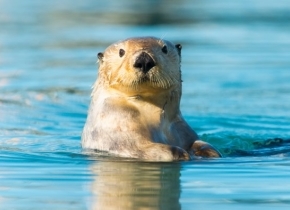
海獭的爪可以敏锐感知猎物
海洋哺乳动物有着非常灵敏的触觉,可以在没有其他感官线索的情况下捕捉猎物。克里斯托弗·因塔利亚塔报道。
撰文\播音:克里斯托弗·因塔利亚塔(Christopher Intagliata)
翻译:邱燕宁
审校:郭晓
Sea otters are pretty petite compared to other marine mammals. Which means that, despite their fur coats, they tend to lose heat quickly, and need lots of energy to stay warm.
海獭比其他海洋哺乳动物都要娇小。这意味着尽管它们穿着“毛皮大衣”,但它们往往会很快失去热量,并需要大量的能量来保暖。
"So they need to eat 25 percent of their body weight each day." Sarah McKay Strobel, a sensory ecologist at U.C. Santa Cruz. "But in order to eat that much food, that means sea otters need to find all that food. And that's where we come in."
“所以它们每天需要进食自己体重25%的食物。”,加州大学圣克鲁斯分校的感官生态学家Sarah McKay Strobel如是说。“但是为了吃那么多的食物,海獭首先需要找到这些食物。这就是我们的切入点。”
She and her team studied the otter's senses, to solve the mystery of how they're such efficient foragers. Vision isn't reliable, she says—it's pretty dark and murky underwater, and crabs and clams tend to hide. Hearing is also tough for otters, in the noisy underwater environment. And sniffing's no good either. "When they're underwater they're holding their breath."
她和她的团队研究了海獭的感官,以解开海獭为何能如此高效觅食的谜团。她说,视力是不可靠的——水下环境很暗,而螃蟹和蛤蜊往往会藏起来。在嘈杂的水下环境中,海獭也很难依靠听觉。依靠嗅觉也不佳。“当它们在水下时,它们会屏住呼吸。”
What's left is touch. So Stroble and her team measured the sensitivity of the otters' paws and whiskers. They blindfolded an otter named Selka, then presented her with plastic plates engraved with tiny grooves, like corduroy. Selka's job was to select the plate with two-millimeter grooves, which she'd been trained to associate with tasty shrimp, instead of plates with differently sized grooves.
剩下的感觉是触觉。于是,Stroble和她的团队测量了水獭爪子和胡须的敏感度。他们把一只名叫Selka的水獭的眼睛蒙上,然后给她一块刻有像灯芯绒一样细纹的塑料盘子。他们训练Selka将带有两毫米凹槽的盘子与美味的虾相关联,然后让她选出这种盘子,而不是带有不同大小凹槽的盘子。
Turns out, Selka could perceive just a quarter millimeter difference in the grooves' width with her paws—above and below water—and half a millimeter difference with her whiskers. "The fact she was able to perform so well while moving incredibly quickly I think is really interesting and suggests that sea otters have very quick decision making abilities, and very quick sensory processing abilities, which makes sense when you think about the type of lifestyle they lead and how quickly they need to find food."
事实证明,Selka能够用她的爪子——在水面上和水下——察觉到沟槽宽度上仅仅0.25毫米的差异,而用她的胡须能察觉到半毫米的差异。“事实上,她能够把任务执行得又好又迅速,我觉得这很有趣,这说明海獭具有快速决策能力以及快速感觉处理能力。考虑到它们的生活方式以及寻找食物所需要的速度,这是非常合理的。”
The full details—and a cute photo of Selka—are in the Journal of Experimental Biology. [Sarah McKay Strobel et al., Active touch in sea otters: in-air and underwater texture discrimination thresholds and behavioral strategies for paws and vibrissae]
完整的研究细节——以及Selka的一张可爱的照片——刊登在《实验生物学杂志》(Journal of Experimental Biology)上。
For the record, humans can feel the difference too, but it takes us 30 times longer. Which might make sense. After all, we evolved in environments where touch was less important in a hunt than were sight and sound.
需要说明的是,人类也能感受到这种差异,但需要30倍的时间。这可能是有道理的。毕竟,在我们进化的环境中,触觉在狩猎中并不如视觉和听觉重要。
未经书面许可任何人不得复制或镜像
京ICP备11000850号
 京公网安备11010502039775号
京公网安备11010502039775号 信息网络传播视听节目许可证0111611号
国家科技基础条件平台

















